Understanding Water Cremation: A Gentler Farewell
Water cremation is an eco-friendly alternative to traditional flame cremation that uses water and alkaline chemicals to reduce a body to its basic elements. Also known as alkaline hydrolysis or aquamation, this process accelerates natural decomposition using a solution of 95% water and 5% alkali (typically potassium hydroxide) in a pressurized stainless steel chamber.
What is water cremation?
- A body disposition method using water, heat, and alkaline chemicals
- Takes 4-16 hours depending on temperature and pressure settings
- Uses approximately 90% less energy than flame cremation
- Produces no direct emissions of harmful greenhouse gases or mercury
- Returns about 20% more ash remains to families
- Legal in 26 U.S. states as of 2023
Water cremation gained significant public attention when Archbishop Desmond Tutu chose it for his own disposition in 2022, highlighting its growing acceptance worldwide. The process mimics natural decomposition but accelerates it from years to mere hours, leaving behind sterile bone fragments that are processed into ash and a nutrient-rich liquid that can be safely returned to the water cycle.
"If more people respect the planet in death, it bodes well for how they'll treat it while they're still alive," notes one industry expert, reflecting the growing environmental consciousness driving interest in this method.
While companies like Bio-Response Solutions and Matthews Environmental Solutions are leading manufacturers of water cremation equipment, American Mortuary Coolers provides the essential refrigeration systems that funeral homes need when implementing this technology.
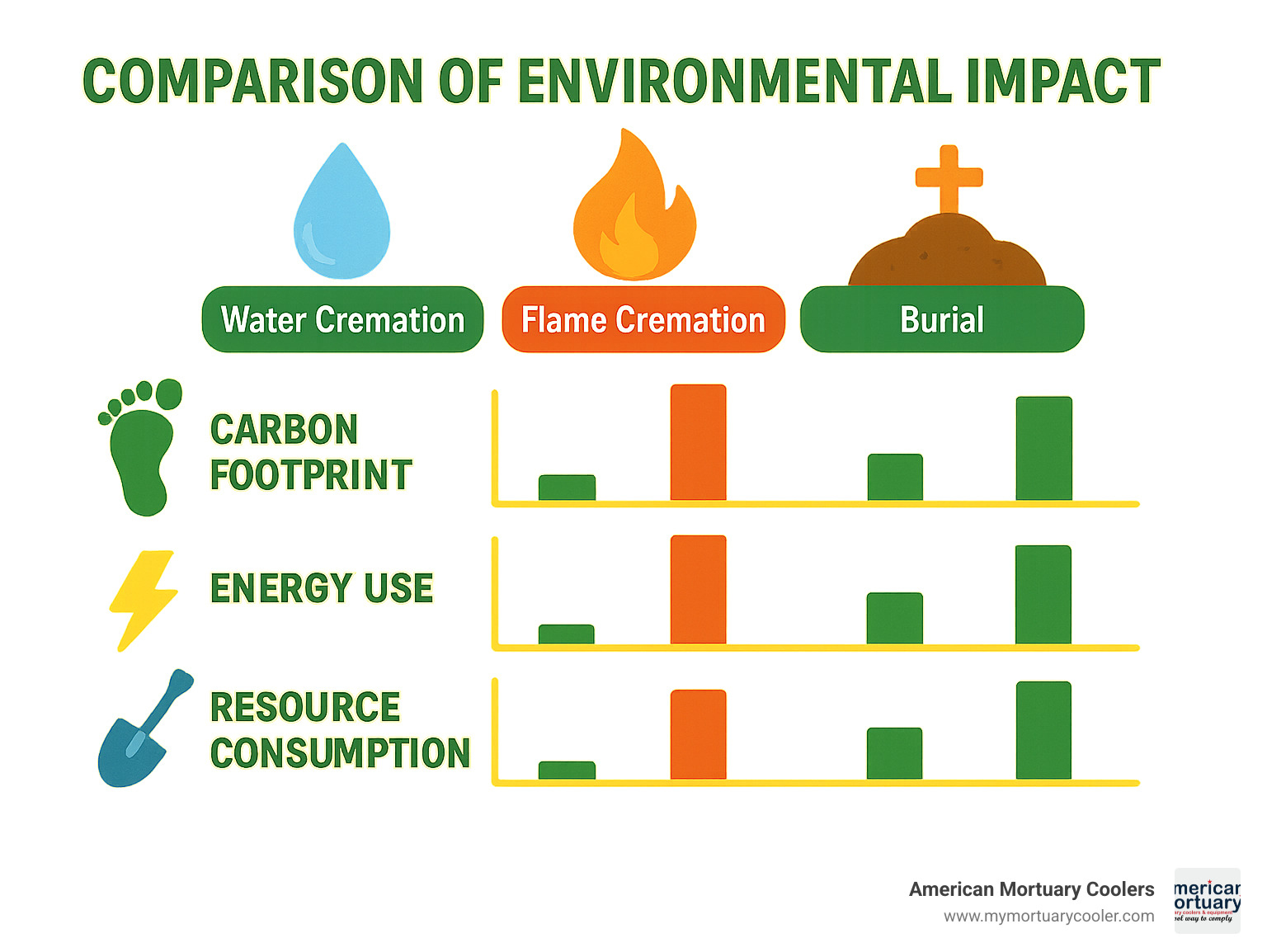
Water cremation further reading:
How the Water Cremation Process Works Step-by-Step
The water cremation process combines simple chemistry with modern technology to create a gentle, dignified farewell. Think of it as nature's decomposition process, but instead of taking years, it happens in just hours.
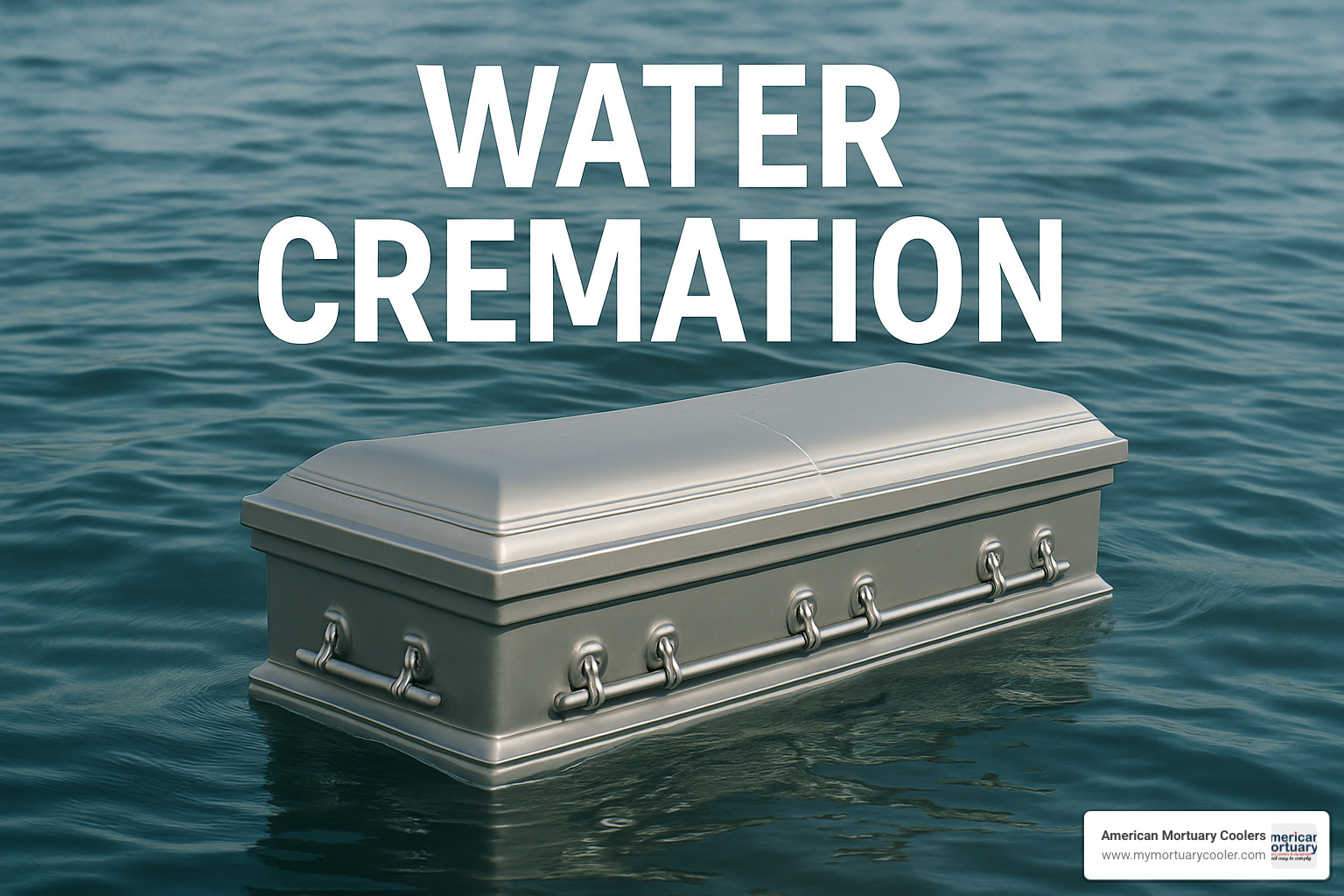
At the heart of this process is a specially designed stainless-steel chamber that resembles a large horizontal cylinder. This sturdy vessel can withstand both heat and pressure while maintaining the dignity of your loved one throughout the entire process.
The journey begins when the body is placed in the chamber, typically wrapped in a simple biodegradable shroud. The chamber fills with a solution that's 95% water and 5% alkali (usually potassium hydroxide). Then, depending on the specific method used, the solution is heated to either 160°C under pressure (taking 4-6 hours) or 98°C at atmospheric pressure (taking 14-16 hours).
As one experienced operator shared with me, "The chemistry is actually quite beautiful. We're simply speeding up what nature would do anyway, but in a controlled, respectful environment."
Throughout the cycle, the solution gently circulates around the body while the pH level gradually decreases from about 14 to 11 as the natural process unfolds. When complete, only bone fragments and non-organic materials like medical implants remain in the chamber. These implants are easily recovered, sterilized, and often recycled—something not possible with flame cremation.
Preparing for Water Cremation
Preparing a loved one for water cremation involves thoughtful but straightforward steps that honor both the person and the planet.
The process begins much like any other end-of-life service—the deceased is transferred to the facility with care and respect. Proper documentation and family authorization are collected, just as with traditional methods.
Unlike flame cremation, water cremation requires minimal preparation. Your loved one is simply wrapped in a biodegradable shroud that dissolves during the process. This simplicity often brings comfort to families seeking a natural approach.
"Families appreciate that there's no need for embalming or elaborate containers," a funeral director told me recently. "It aligns perfectly with the natural philosophy many people hold dear."
One practical benefit is that pacemakers and most medical devices don't need to be removed beforehand—they won't explode as they might in flame cremation. They're simply collected afterward for proper recycling. Throughout the entire process, trained technicians follow strict safety protocols when handling solutions and operating equipment.
Post-Process: From Bones to Ashes & Liquid By-Product
After the water cremation cycle completes, two distinct elements remain—each offering their own form of remembrance and return to nature.
First are the bone fragments, which are carefully collected from the chamber and thoroughly dried. These are then processed in a device called a cremulator—the same equipment used after flame cremation—to create a fine, powder-like substance. The resulting "ashes" are actually pure white calcium phosphate.
Families are often surprised to receive about 20% more cremated remains than they would from flame cremation. The ashes themselves are distinctly whiter and finer in texture, sometimes requiring slightly larger urns. Many families find comfort in this more complete return of their loved one.
The second result is a sterile liquid by-product—about 300-600 gallons depending on the person's size. This nutrient-rich solution is 96% water and contains amino acids, peptides, sugars, and salts. Nothing of the original tissue or DNA remains—everything has been completely broken down to its basic elements.
"The effluent is completely sterile and actually contains beneficial nutrients," explains one provider. "In some jurisdictions, it's being used to nourish plants and trees, completing a beautiful cycle of life."
This liquid has a pH around 11 (alkaline) and is typically neutralized before being safely discharged into municipal wastewater systems with proper permits.
Water Cremation vs. Traditional Flame Cremation & Burial
When families face end-of-life decisions, understanding how water cremation compares to traditional options can help them make choices that align with their values, budget, and environmental concerns.
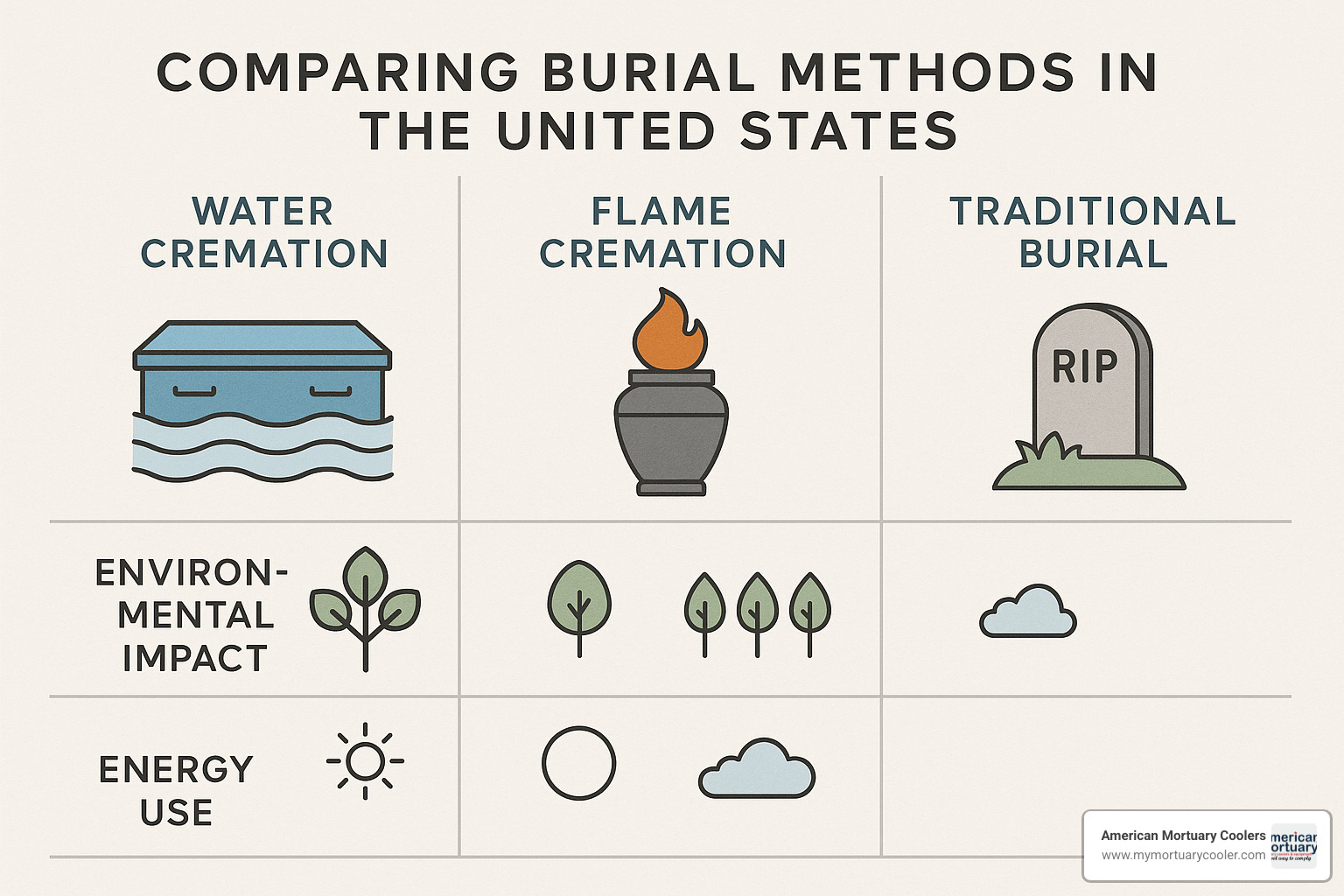
Environmental Impact Comparison
The environmental differences between these options are striking. Water cremation uses approximately 90% less energy than flame-based cremation, making it a standout choice for the eco-conscious. While traditional flame cremation requires substantial fossil fuel to reach temperatures exceeding 1500°F, aquamation achieves similar results with significantly less energy consumption.
"When we explain that flame cremations across America release an estimated 360,000 metric tons of carbon dioxide annually, many families are immediately drawn to water cremation's gentler footprint," shares one funeral director who recently added the service.
Water cremation also eliminates concerns about mercury emissions from dental fillings, which become airborne during flame cremation. For families worried about conventional burial's environmental toll—including the 800,000 gallons of embalming fluid and 30 million board feet of hardwoods buried annually in American soil—aquamation offers peace of mind.
While the process does use 300-600 gallons of water, this resource returns to the water cycle, unlike the concrete, metals, and treated woods permanently committed to the earth with traditional burial.
Process Comparison
The differences in how each option works can influence family decisions significantly. Water cremation takes between 4-16 hours depending on the system used, operating at temperatures between 98°C-160°C—much gentler than flame cremation's intense 760°C-980°C heat that completes in 2-3 hours.
"Families often appreciate that water cremation is a more gentle process," notes one provider. "The remains are also different—pure white calcium phosphate rather than the gray-brown ash from flame cremation, and there's about 20% more volume, which some find comforting."
Viewing options remain similar to flame cremation, with opportunities before the process begins. Memorial options also remain virtually identical across cremation methods, while traditional burial offers both pre-service viewing and graveside ceremonies.
| Aspect | Water Cremation | Flame Cremation | Traditional Burial |
|---|---|---|---|
| Duration | 4-16 hours | 2-3 hours | N/A |
| Temperature | 98°C-160°C | 760°C-980°C | N/A |
| Remains | White calcium phosphate (20% more volume) | Gray/brown ash with carbon | Intact body (decomposing) |
| Viewing Options | Before process | Before process | Before and during service |
Cost Comparison
For many families, budget considerations play a crucial role in their decision-making. Water cremation typically costs between $2,000-$4,000 for direct disposition without additional services. This places it slightly higher than flame cremation ($1,500-$3,000) but substantially lower than traditional burial, which averages $7,000-$12,000+ when including basic services, casket, vault, and cemetery plot.
"When we explain the full picture to families, including environmental benefits and the gentler nature of the process, many feel the slightly higher cost of water cremation is well justified," explains a funeral director in Portland who reports that 85% of families choose aquamation over flame cremation when given both options.
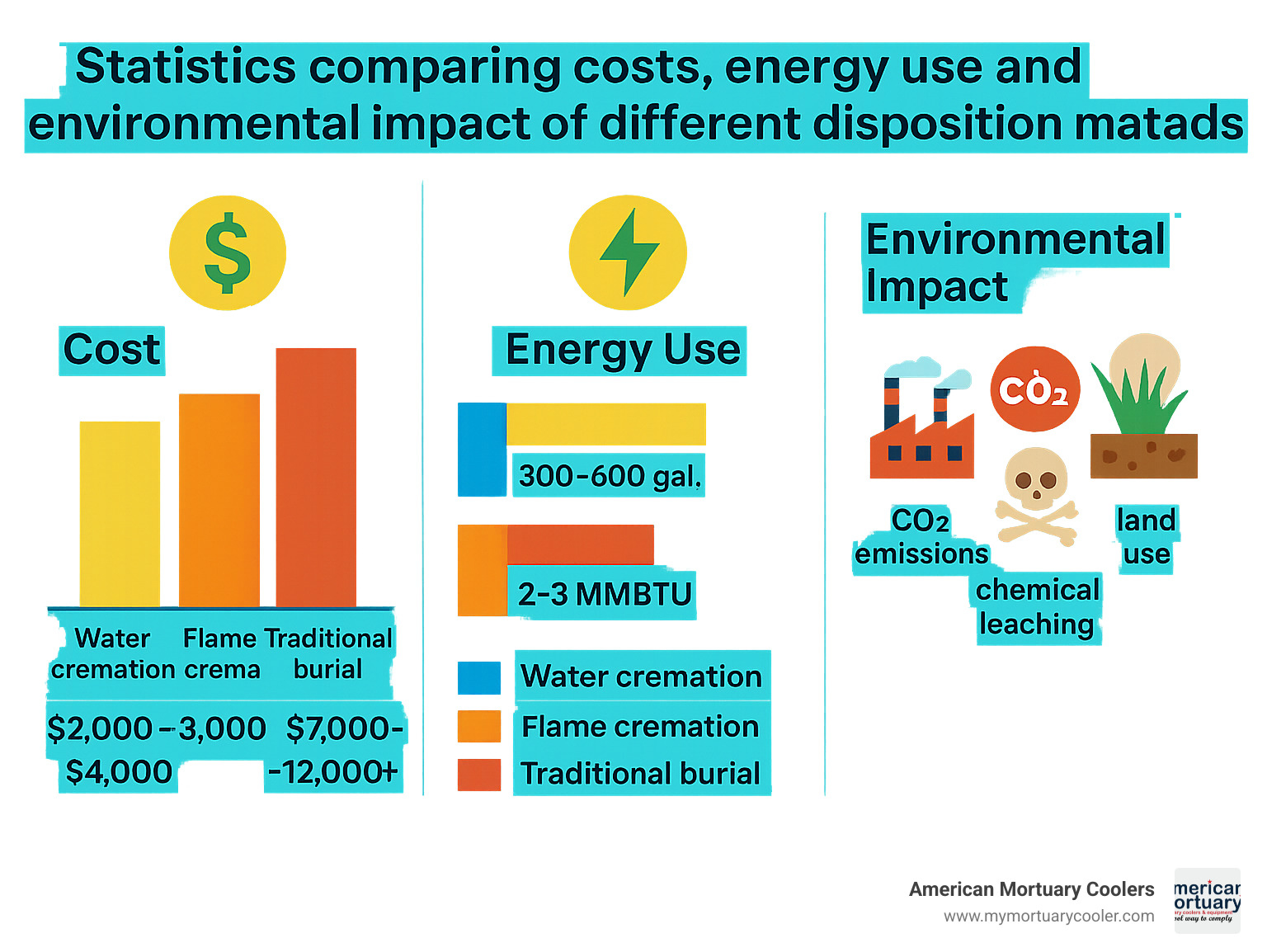
Environmental, Legal & Cultural Landscape
The story of water cremation is unfolding at a fascinating crossroads where environmental consciousness meets legal frameworks and cultural traditions. This intersection helps explain both its growing appeal and the challenges it continues to face.
Environmental Considerations
When we look beyond the energy savings, water cremation offers a suite of environmental benefits that many families find compelling:
The process eliminates mercury emissions from dental fillings – a significant concern with traditional flame cremation that sends this toxic metal into our air. There's no release of particulate matter either, which means cleaner air for surrounding communities.
What's particularly interesting is how the effluent (liquid) created during the process can actually benefit municipal wastewater systems rather than burden them. The sterile, nutrient-rich solution is essentially returning organic materials to the water cycle in a usable form.
"We've partnered with a local tree farm to use our effluent as fertilizer," shares one funeral home director in Oregon. "Families love knowing their loved one is helping new life grow. It creates a beautiful full circle moment."
Studies consistently show water cremation has the lowest carbon footprint of any disposition method available today. Plus, medical implants like titanium hip joints can be easily recovered afterward and recycled – something that's much more difficult after flame cremation.
Where Is Water Cremation Legal?
The legal landscape for water cremation continues to evolve, with availability expanding steadily across North America and beyond. As of 2023, it's legal in 26 U.S. states, with more considering legislation each year.
United States legality varies significantly by region:
Already operational in states like California, Colorado, Florida, Georgia, Idaho, Illinois, Kansas, Maine, Maryland, Minnesota, Missouri, Nevada, North Carolina, Oregon, Utah, Vermont, Washington, and Wyoming. Recently legalized states include Connecticut, Delaware, Hawaii, and New York, with several more states considering legislation.
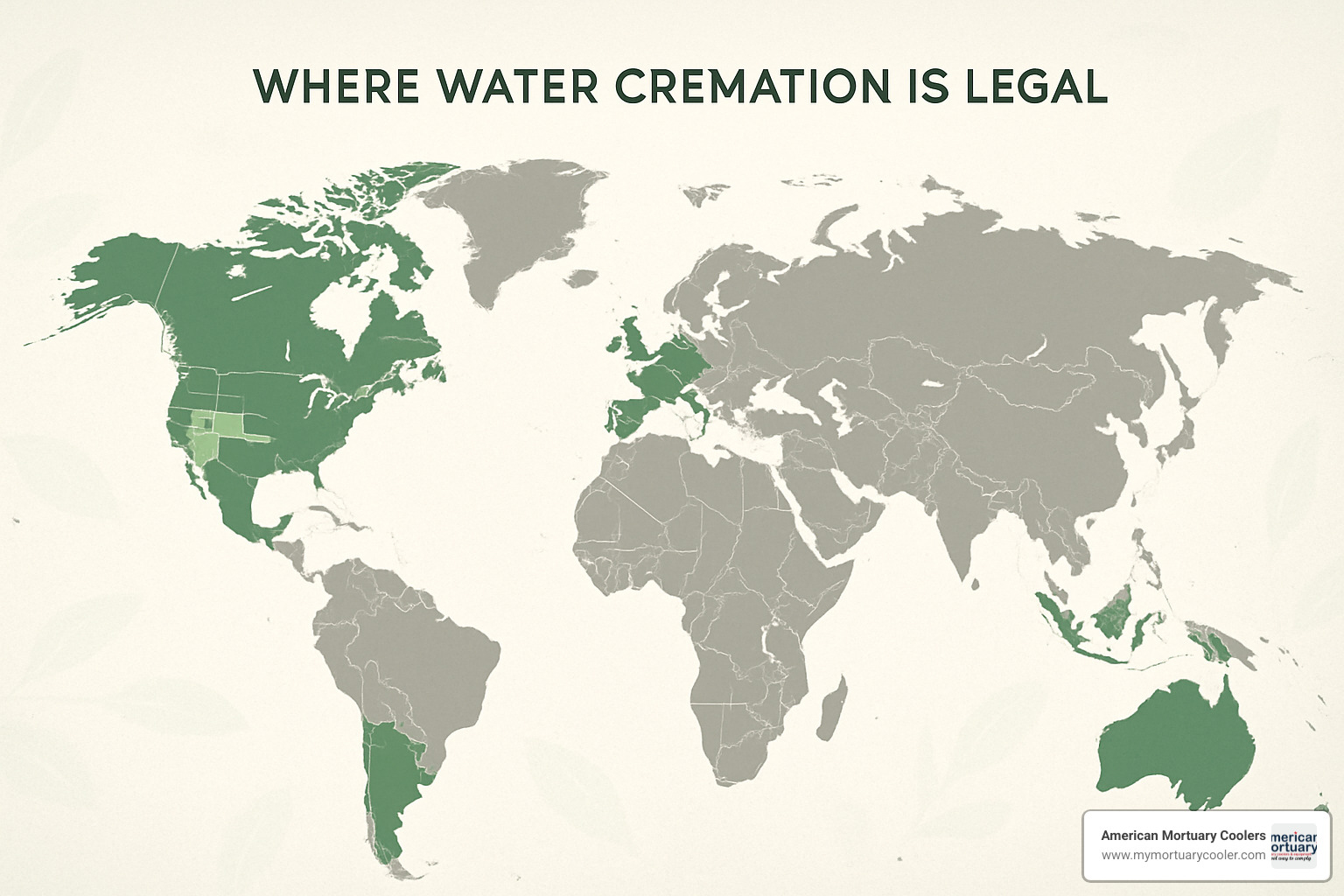
The regulatory journey hasn't always been smooth sailing. Take Ohio, for example, where permits were initially granted then revoked, leading to legal battles. As one funeral director involved in that case put it: "I felt like a fish in a barrel working with regulators. There was no precedent for them to follow."
Faith & Tradition Perspectives on Water Cremation
Religious and cultural viewpoints on water cremation reflect the diversity of our world's traditions:
Within Christianity, most Protestant denominations haven't taken official positions but generally accept it as similar to traditional cremation. The U.S. Conference of Catholic Bishops has expressed some concerns, stating it may be "unnecessarily disrespectful" to the body. However, Catholic bioethicist Renée Mirkes has argued it is morally neutral. Individual Catholic dioceses often have varying positions.
Orthodox Judaism generally opposes any form of cremation, including water cremation, while Reform and Conservative Judaism may be more accepting, though traditional burial remains preferred. Islamic traditions emphasize intact burial, making both forms of cremation generally unacceptable.
Eastern religions like Hinduism and Buddhism, which already accept flame cremation, have shown openness to water cremation as an alternative. What's particularly interesting is how some Native Hawaiian cultural leaders see water cremation as compatible with traditional practices, viewing it as a way to preserve iwi (bones) and mana (spiritual energy).
"People increasingly want their deaths to reflect the values they lived by," observes a funeral director from Washington state. "For those who lived with environmental consciousness, water cremation offers a beautiful alignment between their lifelong values and their final act."
Costs, Providers, and Future Outlook
When families consider water cremation, understanding the costs, finding the right provider, and knowing where this gentle disposition method is headed can make all the difference in their decision-making process.
Cost Breakdown
Water cremation typically costs between $2,000 and $4,000 for a basic service without additional ceremonial elements. This price point puts it in a similar range to traditional flame cremation, though slightly higher in most markets.
What does this base price typically include? The basic service fee, transportation of your loved one, the actual water cremation process, and the return of cremated remains in a simple container. Many families find comfort in this straightforward approach.
"When I explain the pricing to families, they're often surprised it's not significantly more expensive than flame cremation," shares one funeral director from Colorado. "Given the environmental benefits, many feel it's worth every penny."
Of course, personalizing the experience adds to the cost. Memorial services might add $500-$1,000 or more, while a viewing before the process can range from $250-$500. Urns vary widely from $100 to over $2,000 depending on materials and craftsmanship.
For funeral homes considering adding water cremation to their services, the investment is substantial. Equipment from manufacturers like Bio-Response Solutions or Resomation (a division of Matthews Environmental Solutions) costs between $150,000 and $400,000, with installation and facility modifications adding another $50,000-$100,000. However, many providers report strong returns on investment as consumer interest grows.
Choosing a Water Cremation Provider
Finding the right water cremation provider involves more than just comparing prices. Here's what matters most when making this important choice:
Look for proper licensing specific to your state – this technology is regulated differently across the country. Many reputable providers offer facility tours, which can be incredibly reassuring for families with questions about the process.
Transparency matters tremendously. The best providers openly discuss their procedures, clearly outline costs, and explain exactly what happens to your loved one's remains. Some facilities even offer witnessing options, allowing family members to be present at the beginning of the process, similar to what's often available with flame cremation.
For environmentally conscious families, providers with additional green certifications may hold special appeal. And as with any service, experience and reputation speak volumes – don't hesitate to check reviews and ask how long they've been offering water cremation.
As one funeral director in Washington state put it when asked about her own end-of-life preference: "Hands down, I'm choosing water. Having seen both processes up close, there's no comparison in terms of gentleness and environmental impact."
Future Technologies & Industry Trends
The future looks bright for water cremation as both technology and public awareness continue to evolve. Newer equipment from companies like Eco-Green Cremation Systems now offers faster cycles, reduced water usage, and improved energy efficiency – addressing early concerns about resource consumption.
Smaller, more affordable modular units are making this technology accessible to more funeral homes, particularly in rural areas where green options have been limited. This democratization of access is likely to accelerate adoption rates nationwide.
We're also seeing fascinating integration with other green disposition methods. Some forward-thinking providers now offer both water cremation and human composting as complementary eco-friendly alternatives, giving families more choices that align with their values.

For funeral homes considering adding this option, American Mortuary Coolers offers essential supplies and equipment support to help with the transition. Families researching local options can learn more about finding aqua cremation services near them.
Frequently Asked Questions about Water Cremation
When families first hear about water cremation, they naturally have questions. Let's address the most common ones I hear from families considering this gentle alternative.
What remains are returned and how do they differ from flame-cremated ashes?
The remains you receive after water cremation are quite beautiful - a fine, white powder that's pure calcium phosphate. Many families are genuinely surprised by the difference when they see them.
"The first time I showed a family water cremation remains next to traditional ashes, they were amazed by how much purer and whiter they looked," a Colorado funeral director once told me.
These remains are typically about 20% more voluminous than flame cremation ashes, so you might need a slightly larger urn. Unlike the gray-black ashes from flame cremation, which contain carbon, water cremation remains are white because the process doesn't involve burning. You can still keep them in urns, scatter them, or create memorials just as you would with traditional ashes.
What happens to the liquid by-product after water cremation?
This is perhaps the most common question families ask. The liquid that remains after water cremation is essentially a sterile solution of amino acids, peptides, sugars and salts - the basic building blocks of life returned to their elemental form. It's about 96% water with no DNA or tissue remaining.
Most facilities neutralize this slightly alkaline solution (pH around 11) before releasing it into municipal wastewater systems with proper permits. The compounds in this liquid are actually beneficial to wastewater treatment plants, where bacteria use similar nutrients in their processes.
Is water cremation accepted by my religion or culture?
Religious acceptance varies widely, and I always recommend consulting with your spiritual leader if you have concerns.
Most Protestant denominations that accept flame cremation typically have no objections to water cremation. Catholic perspectives can vary by diocese - some accept it while others have reservations. Orthodox Judaism and Islam generally prefer traditional burial over any form of cremation.
Hindu and Buddhist traditions, which already accept flame cremation, are generally accepting of water cremation as well. Many Native Hawaiian cultural leaders see it as compatible with traditional practices that honor iwi (bones) and mana (spiritual energy).
One Catholic family I know found comfort when their priest blessed the water before the process. These personal adaptations can help bridge traditional practices with newer methods.
How long does the water cremation process take?
The timing depends on which method is used:
High-temperature method runs at about 160°C (320°F) and takes 4-6 hours total, while the low-temperature method operates at 98°C (208°F) and takes 14-16 hours.
Despite these different processing times, families typically receive their loved one's remains within 1-3 days, similar to flame cremation's timeline.
Conclusion
There's something deeply meaningful about how we say our final goodbyes. Water cremation represents not just a technological innovation, but a thoughtful evolution in how we approach death with dignity while honoring our connection to the earth.
Throughout this journey exploring aquamation, we've found a process that embodies gentleness and environmental respect. The numbers tell a compelling story - water cremation uses a remarkable 90% less energy than traditional flame cremation while producing zero direct emissions of greenhouse gases or mercury. Families receive about 20% more ash remains, beautifully white and pure, creating a meaningful keepsake of their loved one.
Perhaps what's most beautiful about this process is how it completes a natural cycle. The sterile effluent, rather than being merely a byproduct, can nourish new life when beneficially reused in agriculture or tree farms. There's poetry in that circle of return.
"When my mother chose water cremation, it felt like her final gift to the planet she loved so deeply," shared one family member. "Knowing her final act aligned with how she lived brought us tremendous peace."
As regulations continue to evolve across America and around the world, water cremation is steadily moving from alternative to mainstream. With costs comparable to traditional cremation in most markets, the financial barrier is minimal when weighed against the environmental benefits.
While companies like Bio-Response Solutions and Matthews Environmental Solutions lead in manufacturing the actual water cremation equipment, American Mortuary Coolers provides the essential refrigeration systems that funeral homes need when implementing this technology. From our Tennessee headquarters, we've supported funeral homes nationwide as they adopt this gentle alternative.
When Archbishop Desmond Tutu chose water cremation for his final disposition, he sent a powerful message that resonated globally - this isn't merely an option for environmental activists, but a dignified choice for anyone wishing to leave a lighter footprint as their final act.
As we look to the future, water cremation reminds us that even in death, we can make choices that reflect our values and care for the world we leave behind.
For funeral homes interested in learning more about equipment and supplies for water cremation, we invite you to explore more information on aquamation equipment & supplies.
















